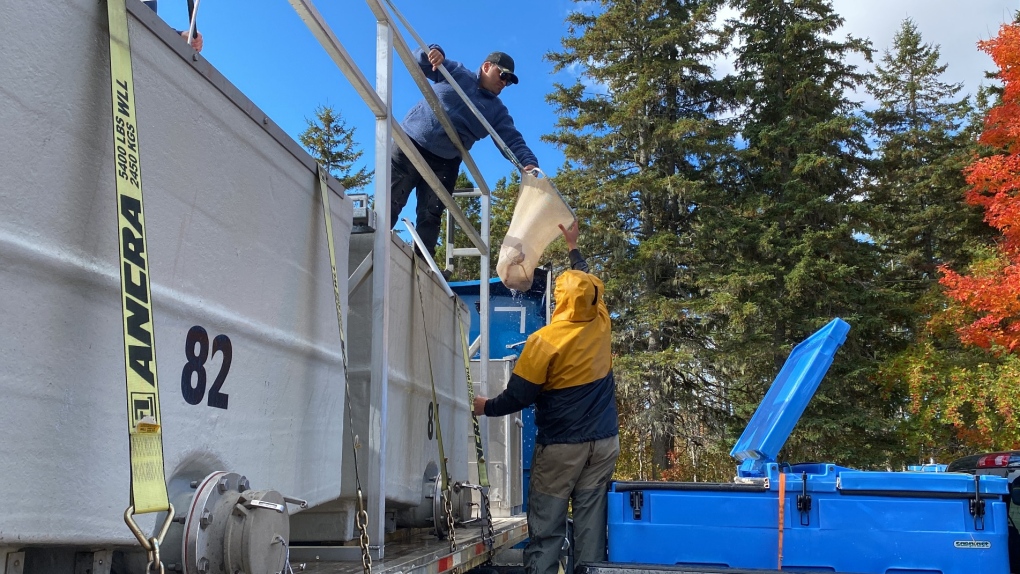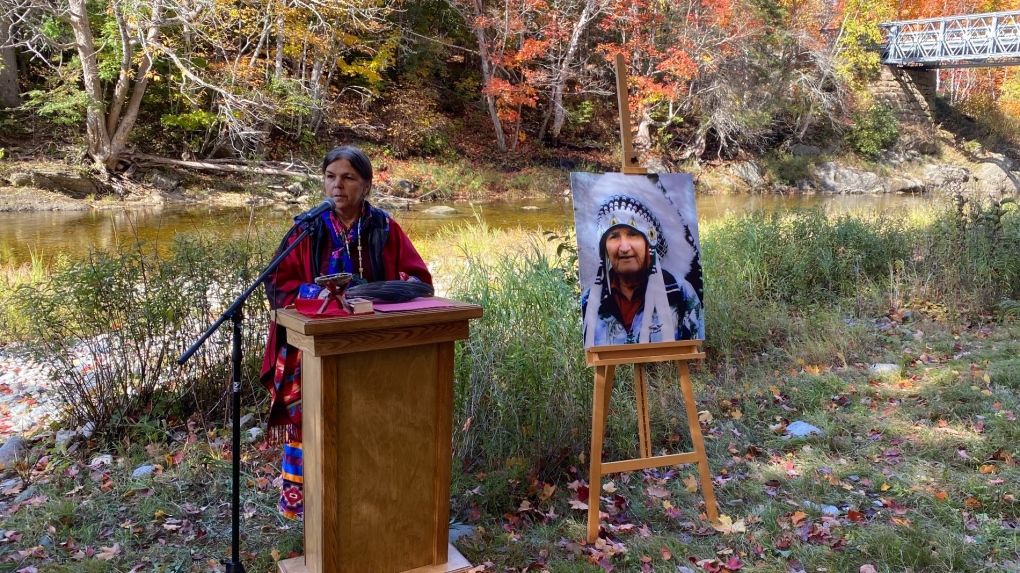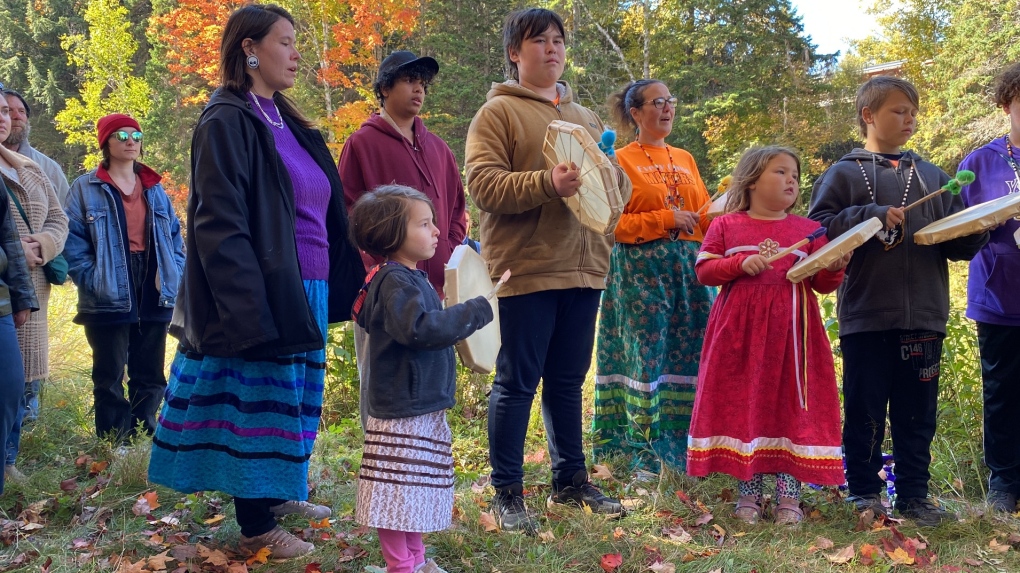Indigenous ceremony, release held for 'critically endangered' species in New Brunswick
Dozens gathered along the bank of the Pollet River in Elgin, N.B., on Friday for a spiritual ceremony and a significant event.
Amlamgog (Fort Folly) First Nation leaders and elders, and the Fundy Salmon Recovery team, have worked together for years to re-establish the salmon population in the Petitcodiac watershed.
Amlamgog Mi'gmaq cultural coordinator Nicole Porter said the partnership with numerous government, private and academic organizations is an effort to bring the Atlantic salmon from the inner Bay of Fundy back to the Petitcodiac watershed.
“We’ve been doing this for over 20 years and we’re starting to see improvements every time that we do adult salmon release in here,” said Porter. “As Mi'gmaq, we have a strong relationship to the salmon, to the water, to Mother Earth and our plants and the trees so we want to honour and respect those.”
This year will see the largest number of endangered Atlantic salmon released by the Fundy Salmon Recovery project.
In September and October alone, more than 1,300 mature salmon will be released into rivers and streams.
 Teams released Atlantic salmon at a New Brunswick river on Oct. 11, 2024. (Source: Derek Haggett/CTV News Atlantic)
Teams released Atlantic salmon at a New Brunswick river on Oct. 11, 2024. (Source: Derek Haggett/CTV News Atlantic)
University of New Brunswick – Saint John associate professor Kurt Samways explained the need for release efforts.
“This population is critically endangered. There was once around 40,000 in about 40-or-50 rivers collectively. We’re down to less than 200 wild salmon back in this population. Without these kind of efforts, there would be no inner Bay of Fundy salmon left,” said Samways.
Fort Folly Habitat Recovery director of salmon recovery Tim Robinson described the process and the work the collective is doing.
Robinson said the salmon released back into the water on Friday came from a conservation farm on Grand Manan Island.
“Those fish were originally collected from the Petitcodiac River as wild juveniles and transported to the farm at Dark Harbour where for the last two years they’ve been raised to maturity, to adulthood,” said Robinson.
Now those adult salmon are ready to spawn.
“We’re bringing them back to the river and putting them on the prime spawning areas on the Pollett River and then the males, females they’ll choose one another,” said Robinson. “They’ll spawn and there will be a natural next generation as a result of that.”
Friday’s ceremony was dedicated to the late Fort Folly Chief Joseph ‘Joe’ Knockwood, an environmental activist who fought for the recovery of Atlantic Salmon in the Petitcodiac.
 Fort Folly First Nations elder Donna Augustine speaks at an Atlantic salmon release ceremony on Oct. 11, 2024. (Source: Derek Haggett/CTV News Atlantic)
Fort Folly First Nations elder Donna Augustine speaks at an Atlantic salmon release ceremony on Oct. 11, 2024. (Source: Derek Haggett/CTV News Atlantic)
According to a new release from Fort Folly Habitat Recovery, Chief Knockwood’s efforts to have the causeway between Moncton and Riverview removed to restore endangered salmon populations were well known.
He formed many partnerships in the early 2000s, including with Parks Canada and the Department of Fisheries and Oceans that still exist today.
Knockwood passed away in December 2023.
“His legacy still lives within our community and we’re still fighting for those salmon just as the way he fought back in the beginning for this to work,” said Porter.
 Amlamgog (Fort Folly) First Nations leaders and elders, and the Fundy Salmon Recovery team, released Atlantic salmon at a New Brunswick river on Oct. 11, 2024. (Source: Derek Haggett/CTV News Atlantic)
Amlamgog (Fort Folly) First Nations leaders and elders, and the Fundy Salmon Recovery team, released Atlantic salmon at a New Brunswick river on Oct. 11, 2024. (Source: Derek Haggett/CTV News Atlantic)
Robinson said Knockwood had the vision to get youth from his Indigenous community involved in environmental conservation work.
“He was a great man. He was a visionary in that he recognized that as is the Mi'gmaq way, that he has to be thinking about the future generations and he saw that the [Petitcodiac] river had been dealt this murderous blow to a number of fish species in the form of that causeway structure. He worked hard to see it opened and ultimately removed,” said Robinson.
For more New Brunswick news, visit our dedicated provincial page.
CTVNews.ca Top Stories

DEVELOPING Ukrainian drone attack was underway before Azerbaijani plane crashed, Russian aviation chief says
Russia's aviation chief said Friday that a Ukrainian drone attack was underway in the Russian region that an airliner was destined for before it diverted and crashed earlier this week.
Another stowaway is caught on a Delta flight this holiday season – raising major concerns about airport safety
Yet another stowaway managed to board a major airline’s plane – renewing serious questions and concerns about airport safety during the busiest travel season of the year.
What Canada can learn from Trump's 2024 presidential campaign
Donald Trump smiled wide in front of cheering supporters after millions of Americans went to the polls, choosing the divisive Republican leader as the next president of the United States in an astonishing comeback that signalled an American turn to isolationism, protectionism and tariffs.
LeBlanc, Joly to meet with incoming Trump administration officials in Florida
Finance Minister Dominic LeBlanc and Foreign Affairs Minister Mélanie Joly are in Florida to meet with officials from president-elect Donald Trump's incoming administration.
Northern Ont. police shoot man carrying a shotgun on Hwy. 11/17
The province’s Special Investigations Unit is investigating after a police office near Thunder Bay, Ont., shot and wounded a man who fired on a police cruiser with a shotgun.
Bloc Quebecois as official Opposition? Leader says Canadians 'don't have to fear us'
Bloc Quebecois Leader Yves-Francois Blanchet says he's staying modest about the prospect of his party forming official Opposition in the next federal election, though it would be a 'spectacular' result.
9-year-old girl dead in Calgary Boxing Day crash
A nine-year-old girl has died in hospital after the vehicle she was in was struck by a stolen vehicle fleeing from police.
B.C woman awarded nearly $750K in court case against contractor
A B.C. woman has been awarded nearly $750,000 in damages in a dispute with a contractor who strung her along for a year and a half and failed to complete a renovation, according to a recent court decision.
Japan's scenic hot springs town restricting tourists amid fights over the best photo spots
Ginzan Onsen, a popular Japanese hot spring town known for its scenic snowy views, has begun limiting entry to day trippers during winter peak season.
































